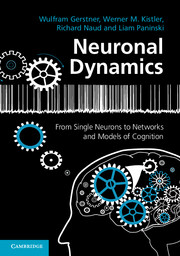Book contents
- Frontmatter
- Contents
- Preface
- PART ONE FOUNDATIONS OF NEURONAL DYNAMICS
- PART TWO GENERALIZED INTEGRATE-AND-FIRE NEURONS
- PART THREE NETWORKS OF NEURONS AND POPULATION ACTIVITY
- PART FOUR DYNAMICS OF COGNITION
- 16 Competing populations and decision making
- 17 Memory and attractor dynamics
- 18 Cortical field models for perception
- 19 Synaptic plasticity and learning
- 20 Outlook: dynamics in plastic networks
- References
- Index
17 - Memory and attractor dynamics
Published online by Cambridge University Press: 05 August 2014
- Frontmatter
- Contents
- Preface
- PART ONE FOUNDATIONS OF NEURONAL DYNAMICS
- PART TWO GENERALIZED INTEGRATE-AND-FIRE NEURONS
- PART THREE NETWORKS OF NEURONS AND POPULATION ACTIVITY
- PART FOUR DYNAMICS OF COGNITION
- 16 Competing populations and decision making
- 17 Memory and attractor dynamics
- 18 Cortical field models for perception
- 19 Synaptic plasticity and learning
- 20 Outlook: dynamics in plastic networks
- References
- Index
Summary
Humans remember important events in their lives. You might be able to recall every detail of your first exam at college, or of your first public speech, or of your first day in kindergarten, or of the first time you went to a new school after your family moved to a new city. Human memory works with associations. If you hear the voice of an old friend on the phone, you may spontaneously recall stories that you had not thought of for years. If you are hungry and see a picture of a banana, you might vividly recall the taste and smell of a banana … and thereby realize that you are indeed hungry.
In this chapter, we present models of neural networks that describe the recall of previously stored items from memory. In Section 17.1 we start with a few examples of associative recall to prepare the stage for the modeling work later on. In Section 17.2 we introduce an abstract network model of memory recall, known as the Hopfield model. We take this network as a starting point and add, in subsequent sections, some biological realism to the model.
Associations and memory
A well-known demonstration of the strong associations which are deeply embedded in the human brain is given by the following task. The aim is to respond as quickly as possible to three questions.
- Type
- Chapter
- Information
- Neuronal DynamicsFrom Single Neurons to Networks and Models of Cognition, pp. 442 - 466Publisher: Cambridge University PressPrint publication year: 2014
- 1
- Cited by



